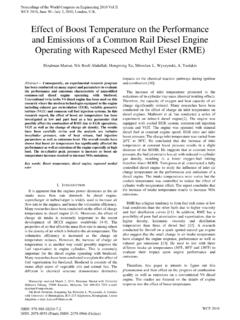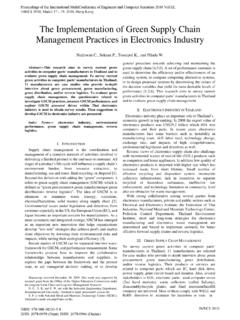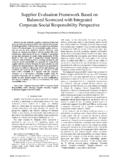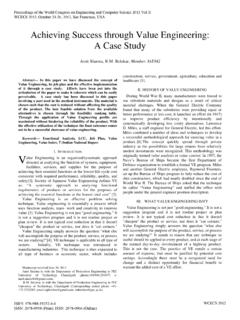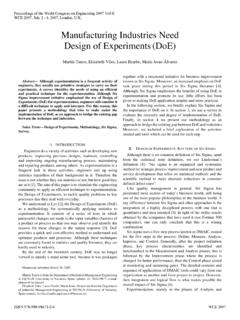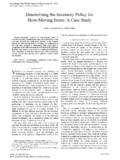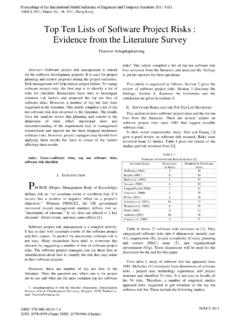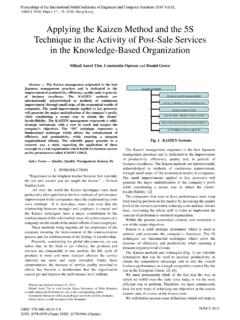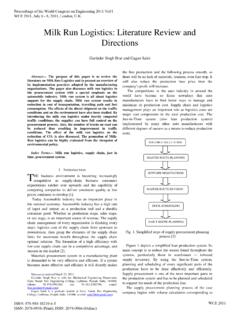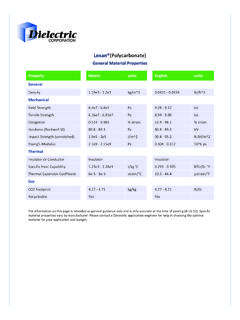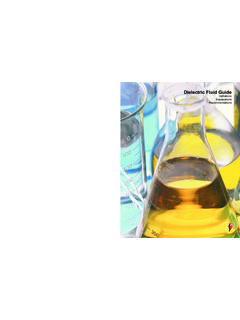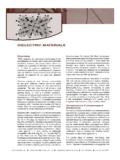Transcription of The Effect of Frequency and Temperature on Dielectric ...
1 Proceedings of the International MultiConference of Engineers and Computer Scientists 2010 Vol III, IMECS 2010, March 17 - 19, 2010, Hong Kong The Effect of Frequency and Temperature on Dielectric properties of Pure Poly Vinylidene Fluoride (PVDF) Thin Films Vikram S Yadav Member, IAENG, Devendra K Sahu, Yashpal Singh Member, IAENG, and the fabrication process. This is due to the fact that PVDF. Abstract In this work we have evaluated the Dielectric exists in several crystalline phases and the predominance of properties of poly vinylidene fluoride (PVDF) thin films of the individual phases can be controlled by the film thickness ( 20 m) as a function of Temperature from 40-700C. fabrication process. The relaxation behavior of PVDF is and Frequency varying from 500 Hz to 100 kHz respectively for Al-Al and Cu-Cu electrode configuration. The Dielectric strongly dependent on its crystalline morphology.
2 The constant values increases with the increase in Temperature . A Dielectric loss of thin films is very important behavior broad peak is found at around (70 5)0C. The maximum value because their possible technical application for insulation of Dielectric constant and Dielectric losses were attributed to and isolation in microelectronic circuits. Tanaka [8]. the phase transition of the polymer. The variation in Dielectric investigated Dielectric relaxation in polymers. constant and loss tangent suggest the net Effect of some internal This work reports the results of Dielectric properties field within the polymer along with the external field. ( Dielectric constant and Dielectric losses) of poly vinylidene Index Terms Poly Vinylidene Fluoride (PVDF), Space fluoride as a function of Temperature and Frequency with Al- Charge Polarization, Dipole Orientation.
3 Al and Cu-Cu electrode combination. This might assist in understanding the relaxation processes in PVDF more clearly. I. INTRODUCTION. The Dielectric constant and dissipation factor are the II. THEORY OF Dielectric BEHAVIOR. crucial quantities in the design of a device. These quantities Debye [9] gave the classical picture of relaxation of are invaluable to engineers in their design of microelectronic polarization with a single relaxation time. In his work he equipments. The physicists, on other hand, are more considered a set of non-interacting dipoles free to rotate in interested in the microscopic processes responsible for the opposition to some viscous resistance in a fluid like Dielectric relaxation. Moreover, the study of Dielectric medium. The equation for complex permittivity is constant and Dielectric loss factor, as a function of Temperature and frequencies is one of the most convenient 1.
4 And sensitive methods of studying the polymer structure [1]. Where = Dielectric constant at low Frequency The Dielectric properties ( Dielectric constant and Dielectric loss) of a number of polymers have been investigated in the = Dielectric constant at high Frequency last two decades [2-7], but the molecular orientation = Angular Frequency behavior and associated relaxation mechanism are not fully = Relaxation time understood. The Dielectric properties of poly vinylidene According to Frohlich, the real and imaginary part of the fluoride (PVDF) polymer films are strongly dependent on Dielectric constant are given by Manuscript received,December 17, 2009. and ". Vikram S Yadav PhD. Member IAENG, is Reader with the Department of Applied Sciences and Humanities, Bundelkhand Institute of The maximum value of ' and '' is, Engineering and Technology, Jhansi, INDIA.
5 284128 (Phone: +91-510- 2320349; fax: +91-510-2320349; e-mail: and ". Devendra K Sahu is Lecturer with Department of Physics, Institute of 3 2 4. Basic Sciences, Bundelkhand University, Jhansi-284128 INDIA. (Phone: . +91-9415947697; e-mail: 2 3 3. Yashpal Member IAENG is Reader and Head with the Where n = Dipole Moment Computer Science and Engineering Department, Bundelkhand Institute of g = Parameter related to dipole interaction Engineering and Technology, Jhansi-284128 (INDIA) (phone: +91- 9415030602; fax: +91-510-2320349;e-mail: T = Temperature is Reader and Head with the Electronics and The polymers rarely follow the Debye theory and they Communication Engineering Department, Bundelkhand Institute of Engineering show much broader dispersion and low loss as compared to and Technology, Jhansi-284128 (INDIA) (phone: +91- 9415030602; fax: +91- 510-2320349;e-mail: single relaxation process.))))
6 Cole [10] pointed out this anomaly arises due to the fact that the chain molecular compounds do ISBN: 978-988-18210-5-8 IMECS 2010. ISSN: 2078-0958 (Print); ISSN: 2078-0966 (Online). Proceedings of the International MultiConference of Engineers and Computer Scientists 2010 Vol III, IMECS 2010, March 17 - 19, 2010, Hong Kong not have a single relaxation time. On the contrary their expression for Dielectric loss is given by the equation [18, relaxation times are distributed within certain minimum and 19], maximum limits. Every molecular dip[ole in a given chain is coupled to neighboring dipole of the same chain by primary tan 1. valence bands so the motion of any dipole affects the motion where Gin is the conductance for the residual current. of neighbors and they in turn influence its response to a Obviously, form equation, torque. Further, in various configurations, which in chain.]
7 Molecule can assume, we can find another segment of chain Differentiating equation with respect to and equating the acting effectively as a co-operative electrical unit and these derivative to zero, it is possible to obtain the value of of segments will of course vary in length between the the Frequency corresponding to maximum loss. improbable extremes of a single nonnumeric unit and the whole extended chain. Such a state leads to distribution of III. EXPERIMENTAL. relaxation time. On eliminating the parameter between the two The sample of Poly Vinylidene Fluoride (PVDF) used is equations and rearranging the two parameters ( ' and ) we obtained from Glaxo Laboratories, Mumbai. The polymer get, was dissolved in the DMA (Di-methyl Acetate) at 500C. Films were prepared by casting this solution on glass substrates. The films were detached after the evaporation of ".
8 2 2 the solvent. For measurements aluminum electrodes were deposited on both sides of the films. Dielectric studies were The above equation is of a circle of radius . Only the carried out on the all entire sample to study Dielectric semicircle over which is positive has physical constant and Dielectric loss. The instrument used was significance. Materials with single relaxation time yield a HP4192A impendence analyzer, with Frequency range 500. semicircle in ' and plane. Polymers do not yield such a Hz to 1000 KHz and Temperature range 400C to 700C. semicircle and the '- plane falls within the Debye semicircle. Cole [10] modified the Debye equation by IV. RESULTS AND DISCUSSIONS. empirical equation for the complex permittivity. The Dielectric constant and losses of poly vinyledene fluoride samples are observed in the Temperature of range 1. Where is an empirical parameter.
9 It lies between 0 and 1 400C to 700C with Frequency range 500 Hz to 1000 KHz. and it denotes the angle of tilt of circular arc from real axis. The results are interpreted in terms of existing theories. The modified expression measures the small deviation A. Dielectric Constant from the ideal Debye behavior, but some material deviates 1. Effect of Temperature very much the Debye behavior. Havirilik and Negami [11]. To observe an Effect of Temperature on Dielectric gave an expression which is of the form, constant, its variation as a function of Temperature is plotted at different frequencies ( 500 Hz, 2,10, 100, 1 500 and 1000 KHz) are shown in the figures 1 and 2. The Dielectric constant and losses were calculated using the for Al-Al and Cu-Cu combinations. It is clear from equation valid for parallel plate capacitor, these figures that the value of Dielectric constant decreases with increasing frequencies.
10 For higher And " tan frequencies the value of Dielectric constant increases attaining maxima at 700C and then decreasing. This Where Cx is the sample capacitance in Farad, A is area of nature is not observed for other frequencies. the sample, d is the thickness of the sample and 0 is a constant representing permittivity of free space. The variation of Dielectric constant and loss tangent, suggest the net Effect of some internal field within the polymer along with the external A C field. The dipole- dipole interactions between the different groups or many body interactions suggest the lower losses with higher Frequency range. The dependence of the Dielectric constant on Frequency can be determined from the equation, 1. where Cg is the geometrical capacitance, S the conductance corresponding to the absorption current, the dipole relaxation time and the angular Frequency .
